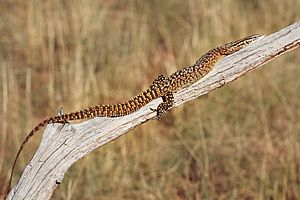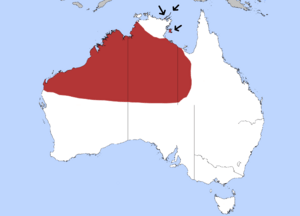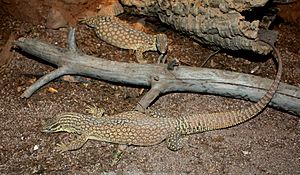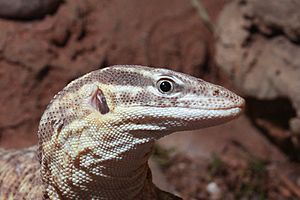Spiny-tailed monitor facts for kids
Quick facts for kids Spiny-tailed monitor |
|
|---|---|
 |
|
| Conservation status | |
| Scientific classification | |
| Genus: |
Varanus
|
| Species: |
acanthurus
|
|
|
 |
|
| Distribution of the spiny-tailed monitor | |
The spiny-tailed monitor (Varanus acanthurus) is a cool lizard from Australia. People also call it the Australian spiny-tailed monitor, the ridge-tailed monitor, or Ackie's dwarf monitor. It's a type of monitor lizard.
Contents
About the Spiny-tailed Monitor
The spiny-tailed monitor is a medium-sized lizard. It can grow up to 70 cm (27 in) long, including its tail. Some reports say wild ones might even reach 34 inches! Its tail is usually 1.3 to 2.3 times longer than its head and body combined.
This lizard has a dark brown back with bright yellow or cream spots. These spots often have a few dark scales inside them. Its tail is round and covered in very spiky scales. It has 70 to 115 scales around the middle of its body. You can tell it apart from similar lizards like V. baritji and V. primordius because it has light-colored stripes on its neck.
Where Spiny-tailed Monitors Live
This lizard loves dry, rocky places. You can find it in northern Western Australia, the Northern Territory, and parts of Queensland. It lives in rocky areas and outcrops.
Different types of spiny-tailed monitors live in different spots:
- V. a. acanthurus is mostly found in northwestern Australia.
- V. a. brachyurus lives in central Australia and up into the Northern Territory.
- V. a. insulanicus only lives on a small island off the coast of Northern Australia.
Types of Spiny-tailed Monitors
The spiny-tailed monitor is part of a group of small monitor lizards called Odatria. This group includes lizards from Indonesia and Australia.
Scientists recognize three main types, or subspecies, of V. acanthurus:
- V. a. acanthurus: Found in northwestern and northern Australia.
- V. a. brachyurus: Lives in western and central Australia, and Queensland.
- V. a. insulanicus: Found on Groote Eylandt and the Wessel group of islands.
Another lizard, Varanus primordius, was once thought to be a type of spiny-tailed monitor. But now, it's considered its own separate species.
In the pet world, you might hear about "red ackie" monitors and "yellow ackie" monitors. The "red ackie" is probably V. a. acanthurus, and the "yellow ackie" is likely V. a. brachyurus.
Scientists are still studying these different types to be sure how they are related. For example, V. a. insulanicus might even be a completely different species because it's more closely related to V. baritji than to other spiny-tailed monitors. It's also easy to spot because it's darker and has more stripes.
Daily Life and Diet
Spiny-tailed monitors are active during the day and usually live alone. They spend most of their time hiding under rocks, boulders, or in rock cracks. Sometimes, they hide in spinifex grass. These lizards don't move around as much as other monitor lizards. They often wait in their hiding spots to ambush their prey.
What They Eat
Their main food is insects, especially grasshoppers. They also eat beetles and cockroaches. About a third of their diet includes small lizards like skinks, geckos, or dragon lizards. Sometimes, they eat other insects, spiders, snails, or even young marsupials. They get about 70% of the water they need from their food!
Reproduction and Life Cycle
In zoos or with breeders, a female spiny-tailed monitor can lay up to 18 eggs at a time. The baby lizards hatch after three to five months of incubation. When they hatch, they are about 15 cm (6 in) long.
We don't know as much about their reproduction in the wild. Male lizards probably become old enough to reproduce when their body (snout to vent) is about 30 cm (12 in) long. Females mature when they are 25–36 cm (10–14 in) long. They usually lay eggs in August and November, digging tunnels to keep their eggs safe.
Images for kids
See also
 In Spanish: Varano de cola espinosa para niños
In Spanish: Varano de cola espinosa para niños





